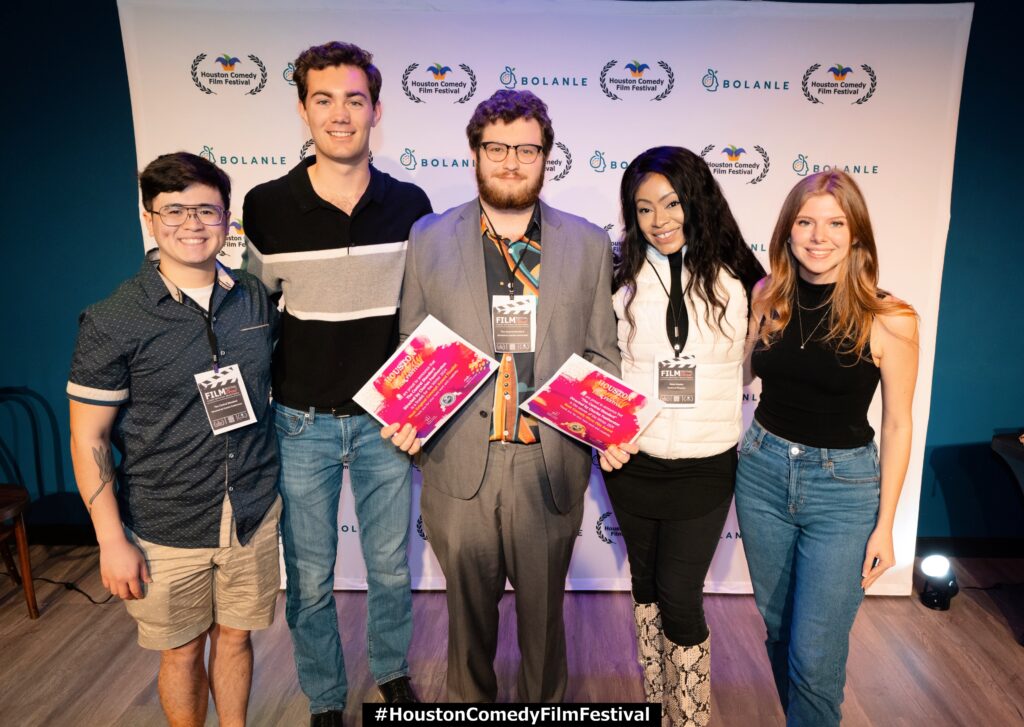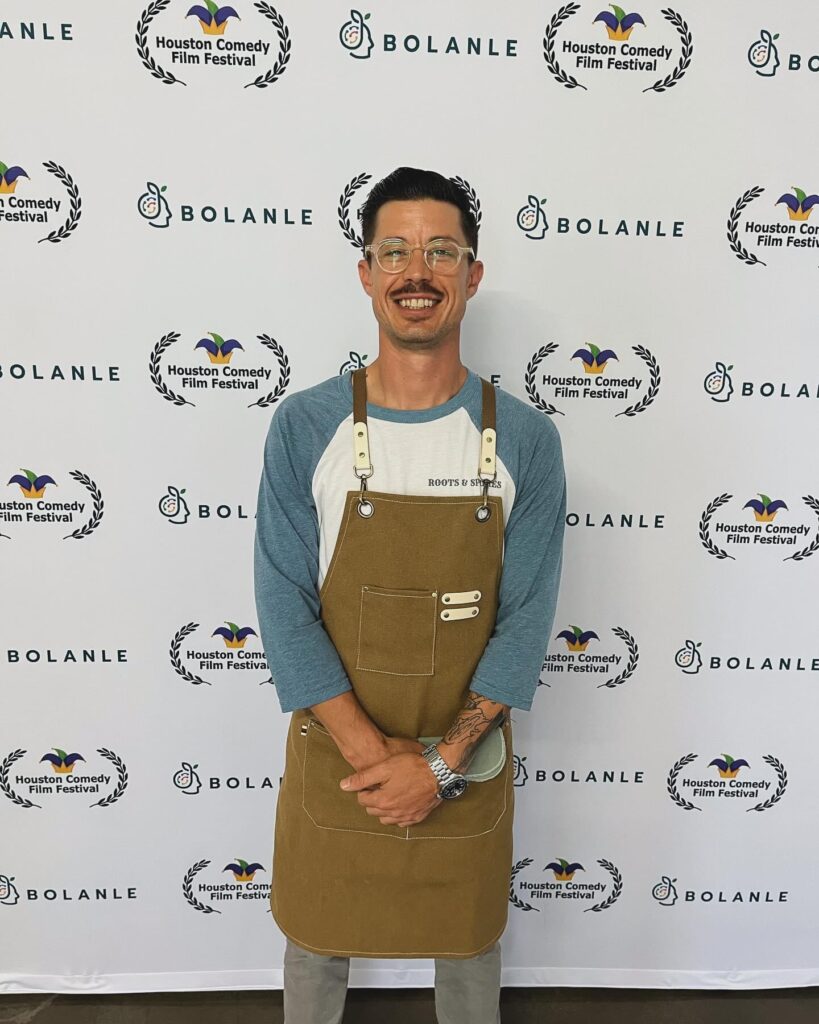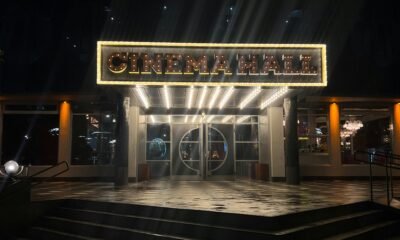Entertainment
Featherston Wins Houston Comedy Fest with ‘The Central Standard’
 Charles Featherston Triumphs at Houston Comedy Film Festival with “The Central Standard”
Charles Featherston Triumphs at Houston Comedy Film Festival with “The Central Standard”
Amidst an atmosphere brimming with laughter and jubilation, director Charles Featherston clinched the prestigious title of Best Comedy Micro Film at the Houston Comedy Film Festival for his outstanding creation, “The Central Standard.” The film, set against the backdrop of a bungled money drop, intricately weaves the uproarious escapades of Louise and Alexi as they find themselves entangled in a race against time.
Featherston’s directorial finesse shines brilliantly in “The Central Standard” as he deftly navigates the intricacies of comedic storytelling with finesse and precision. From its sharp-witted dialogue to its ingenious plot twists, the film enthralls audiences from the opening scene to the closing credits, evoking uproarious laughter with each moment.
With this latest triumph, Featherston solidifies his standing as a rising luminary in the realm of comedy filmmaking. His distinctive vision and undeniable talent continue to captivate both viewers and critics alike, garnering acclaim on local and international platforms.
As Featherston’s star ascends, enthusiasts eagerly await his forthcoming projects with bated breath. With “The Central Standard,” he has unequivocally established himself as a formidable force in the comedy genre, and the anticipation surrounding his future endeavors is palpable.
Heartiest congratulations to Charles Featherston on this well-deserved accolade at the Houston Comedy Film Festival! We eagerly anticipate the brilliance he will unfurl in his future ventures.

Charles Featherston: From Lego Animation to Acclaimed Filmmaker
Charles Featherston’s trajectory from crafting stop-motion Lego animations in his youth to ascending the echelons of filmmaking is a tale suffused with inspiration. A graduate of Baylor University’s class of 2023, Featherston now sets his sights on pursuing Baylor’s MFA program, harboring aspirations of affiliating with both the DGA and EGA in due course.
“The Central Standard,” Featherston’s latest opus, germinated from his final directing assignment, showcasing his ingenuity and artistry in storytelling. Drawing inspiration from the crime cinema of maestros like Guy Ritchie and Martin Scorsese, Featherston infuses his work with a distinctive amalgam of flair and substance, evocative of a lighter-hearted “Pulp Fiction.”
Featherston’s ardor for filmmaking traces its roots back to his formative years in high school, where his passion for editing short-form content was kindled. Presently, as the founder of his own production venture nestled in Waco, Texas, Featherston actively networks with fellow creatives and producers, eagerly seeking collaborations to bring riveting narratives to fruition.
In “The Central Standard,” Featherston delves into the theme of misunderstandings, an omnipresent facet of our tumultuous world, by anchoring the narrative around confusion and crafting compelling story arcs. Though the characters in the film are not modeled after specific individuals, they resonate with Featherston’s acute comprehension of human dynamics, manifesting as relatable and engrossing personas.
As Featherston refines his craft and broadens his portfolio, his commitment to crafting thought-provoking and entertaining content remains unwavering. Presently, he and his team are engrossed in crafting their next short, envisaged as a proof of concept for an expansive television series, underscoring their devotion to storytelling and their vision for the trajectory of their production enterprise.
Track Charles Featherston’s odyssey on Instagram @the_amazing_feathersword and @madfeathers_studios, and stay tuned for a plethora of captivating projects from this luminary in the realm of filmmaking!
Captivating Insights Into Charles Featherston:
1. Featherston’s cinematic journey commenced with childhood endeavors in crafting stop-motion Lego animations.
2. Inspirations from luminaries such as Guy Ritchie and Martin Scorsese significantly influence Featherston’s directorial style.
3. Featherston’s production enterprise, nestled in Waco, Texas, is dedicated to bringing riveting narratives to life.
4. “The Central Standard” has received acclaim as an official selection at various Texas-based festivals, signaling Featherston’s burgeoning acclaim.
5. Featherston’s upcoming endeavor is poised to serve as a tantalizing glimpse into the realms of television, emblematic of his ambition and creativity in the industry.
Please feel free to check out our online store here.
Shoutout to our online sponsor Travis from Roots & Spores Coffee

Roots & Spores Coffee Owner Travis Whitbeck
From the Film Festival Circuit Founder, Mikal Fair:
Entertainment
What We Can Learn Inside 50 Cent’s Explosive Diddy Documentary: 5 Reasons You Should Watch

50 Cent’s new Netflix docuseries about Sean “Diddy” Combs is more than a headline-grabbing exposé; it is a meticulous breakdown of how power, celebrity, and silence can collide in the entertainment industry.
Across its episodes, the series traces Diddy’s rise, the allegations that followed him for years, and the shocking footage and testimonies now forcing a wider cultural reckoning.

1. It Chronicles Diddy’s Rise and Fall – And How Power Warps Reality
The docuseries follows Combs from hitmaker and business icon to a figure facing serious criminal conviction and public disgrace, mapping out decades of influence, branding, and behind-the-scenes behavior. Watching that arc shows how money, fame, and industry relationships can shield someone from scrutiny and delay accountability, even as disturbing accusations accumulate.

2. Never-Before-Seen Footage Shows How Narratives Are Managed
Exclusive footage of Diddy in private settings and in the tense days around his legal troubles reveals how carefully celebrity narratives are shaped, even in crisis.
Viewers can learn to question polished statements and recognize that what looks spontaneous in public is often the result of strategy, damage control, and legal calculation.
3. Survivors’ Stories Highlight Patterns of Abuse and Silence
Interviews with alleged victims, former staff, and industry insiders describe patterns of control, fear, and emotional or physical harm that were long whispered about but rarely aired in this detail. Their stories underline how difficult it is to speak out against a powerful figure, teaching viewers why many survivors delay disclosure and why consistent patterns across multiple accounts matter.
4. 50 Cent’s Approach Shows Storytelling as a Tool for Accountability
As executive producer, 50 Cent uses his reputation and platform to push a project that leans into uncomfortable truths rather than protecting industry relationships. The series demonstrates how documentary storytelling can challenge established power structures, elevate marginalized voices, and pressure institutions to respond when traditional systems have failed.
5. The Cultural Backlash Reveals How Society Handles Celebrity Accountability
Reactions to the doc—ranging from people calling it necessary and brave to others dismissing it as a vendetta or smear campaign—expose how emotionally invested audiences can be in defending or condemning a famous figure. Watching that debate unfold helps viewers see how fandom, nostalgia, and bias influence who is believed, and why conversations about “cancel culture” often mask deeper questions about justice and who is considered too powerful to fall.
Entertainment
South Park’s Christmas Episode Delivers the Antichrist

A new Christmas-themed episode of South Park is scheduled to air with a central plot in which Satan is depicted as preparing for the birth of an Antichrist figure. The premise extends a season-long narrative arc that has involved Satan, Donald Trump, and apocalyptic rhetoric, positioning this holiday episode as a culmination of those storylines rather than a stand‑alone concept.
Episode premise and season context
According to published synopses and entertainment coverage, the episode frames the Antichrist as part of a fictional storyline that blends religious symbolism with commentary on politics, media, and cultural fear. This follows earlier Season 28 episodes that introduced ideas about Trump fathering an Antichrist child and tech billionaire Peter Thiel obsessing over prophecy and end‑times narratives. The Christmas setting is presented as a contrast to the darker themes, reflecting the series’ pattern of pairing holiday imagery with controversial subject matter.
Public and political reactions
Coverage notes that some figures connected to Donald Trump’s political orbit have criticized the season’s portrayal of Trump and his allies, describing the show as relying on shock tactics rather than substantive critique. Commentators highlight that these objections are directed more at the depiction of real political figures and the show’s tone than at the specific theology of the Antichrist storyline.
At the time of reporting, there have not been widely reported, detailed statements from major religious leaders focused solely on this Christmas episode, though religion-focused criticism of South Park in general has a long history.
Media and cultural commentary
Entertainment outlets such as The Hollywood Reporter, Entertainment Weekly, Forbes, Slate, and USA Today describe the Antichrist arc as part of South Park’s ongoing use of Trump-era and tech-world politics as material for satire.
Viewer guidance and content advisory
South Park is rated TV‑MA and is intended for adult audiences due to strong language, explicit themes, and frequent use of religious and political satire. Viewers who are sensitive to depictions of Satan, the Antichrist, or parodies involving real political figures may find this episode particularly objectionable, while others may view it as consistent with the show’s long‑running approach to controversial topics. As with previous episodes, individual responses are likely to vary widely, and the episode is best understood as part of an ongoing satirical series rather than a factual or theological statement.
Entertainment
Sydney Sweeney Finally Confronts the Plastic Surgery Rumors

Sydney Sweeney has decided she is finished watching strangers on the internet treat her face like a forensic project. After years of side‑by‑side screenshots, “then vs now” TikToks, and long comment threads wondering what work she has supposedly had done, the actor is now addressing the plastic surgery rumors directly—and using them to say something larger about how women are looked at in Hollywood and online.

Growing Up on Camera vs. “Before and After” Culture
Sweeney points out that people are often mistaking normal changes for procedures: she grew up on camera, her roles now come with big‑budget glam teams, and her body has shifted as she has trained, aged, and worked nonstop. Yet every new red‑carpet photo gets folded into a narrative that assumes surgeons, not time, are responsible. Rather than walking through a checklist of what is “real,” she emphasizes how bizarre it is that internet detectives comb through pores, noses, and jawlines as if they are owed an explanation for every contour of a woman’s face.
The Real Problem Isn’t Her Face
By speaking up, Sweeney is redirecting the conversation away from her features and toward the culture that obsesses over them.
She argues that the real issue isn’t whether an actress has had work done, but why audiences feel so entitled to dissect her body as public property in the first place.
For her, the constant speculation is less about curiosity and more about control—another way to tell women what they should look like and punish them when they do not fit. In calling out that dynamic, Sweeney isn’t just defending herself; she is forcing fans and followers to ask why tearing apart someone else’s appearance has become such a popular form of entertainment.

 Entertainment4 weeks ago
Entertainment4 weeks agoWicked Sequel Disappoints Fans: Audience Verdict on For Good

 Entertainment4 weeks ago
Entertainment4 weeks agoAriana & Cynthia Say They’re in a ‘Non‑Demi Curious, Semi‑Binary’ Relationship… WTF Does That Even Mean?

 News4 weeks ago
News4 weeks agoMexico Bans Dophin Shows Nationwide

 Entertainment3 weeks ago
Entertainment3 weeks agoColombia’s ‘Doll’ Arrest: Police Say a 23-Year-Old Orchestrated Hits, Including Her Ex’s Murder

 Entertainment4 weeks ago
Entertainment4 weeks agoHow The Grinch Became The Richest Christmas Movie Ever

 Entertainment4 weeks ago
Entertainment4 weeks agoMiley Cyrus Is Engaged to Maxx Morando

 News4 weeks ago
News4 weeks agoUS May Completely Cut Income Tax Due to Tariff Revenue

 Business3 weeks ago
Business3 weeks agoLuana Lopes Lara: How a 29‑Year‑Old Became the Youngest Self‑Made Woman Billionaire









































puravive reviews
February 28, 2024 at 3:55 am
This asset is remarkable. The wonderful substance shows the designer’s enthusiasm. I’m astounded and envision more such fabulous material.
Healthstay
March 2, 2024 at 2:40 pm
Hi there to all, for the reason that I am genuinely keen of reading this website’s post to be updated on a regular basis. It carries pleasant stuff.